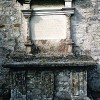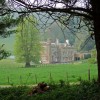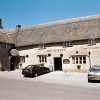Between Bournemouth and Poole lies the heathland parish of Canford, today an area of intense development pressure. However, for most of the earlier 19th century it was an estate of thirteen thousand acres about to be transformed through the intervention of a businessman and his remarkable wife.
The wife in question was born Charlotte Bertie in 1812, the only daughter of the ninth Earl of Lindsay and his wife Charlotte Layard. When young Charlotte was only six her father died and her mother entered into a second marriage to a hard-drinking, violent clergyman called Peter Pegus, whom the wife and step-daughter were later to turn against. Charlotte junior’s response to the intrusion of this disagreeable step-father into her life was to withdraw into herself with the consolation of reading.
Whether or not this habit and her abnormal family life were contributory factors, Charlotte’s abilities expanded such that she developed a phenomenal intellect and capacity for learning, even by today’s standards. She learnt Latin, Greek, Hebrew, Persian, French and Italian; could play the piano and harp, do copper etchings, and find time to go riding, hunting and shooting. Yet her two younger brothers were mentally retarded.
Charlotte also enjoyed frequent trips to London. It was during one of these trips when she was 21 in 1833 that she was introduced to Benjamin Disraeli, who in turn presented her to a venture capitalist of his acquaintance called Josiah John Guest.
Guest was then 48 but of a very different background and age to Charlotte. He was then the owner-manager of an ironworks his grandfather had established at Dowlais near Merthyr Tydfil, and a year before he married Charlotte he had been elected the town’s MP. Over the first twelve years of their marriage they had ten children: five boys and five girls.
In 1838 Charlotte was presented at the court of the newly-crowned Queen Victoria and by the end of that year Sir John, as he was by then, had been made a baronet. Lady Charlotte also sought a position at court, but in 1844 her husband’s health began to fail after undergoing a gall-bladder operation. It was this change in their circumstances that convinced Charlotte that they should seek to make their home in Dorset.
Subsequently in 1845, the Guests purchased the Canford estate for £335,000, Charlotte immediately taking upon herself the mammoth work of re-organisation. The great architect Sir Charles Barry, who a decade before had designed the new Palace of Westminster, was commissioned to re-style Canford Manor as a Gothic mansion – an undertaking that took several years to complete.
Following the opening of the Liverpool to Manchester Railway the Dowlais Ironworks turned to making railway lines. Charlotte became much involved in the day-to-day running of the company, even adding Welsh to her linguistic tally so that she could converse with the labour force at the works. Her mastery of their mother tongue however, further enabled her – over the course of eight years – to undertake the first translation of the Welsh folklore epic The Mabinogion into English.
Sir John died in Charlotte’s arms in 1851, barely a year after the Guests were able to move into their mansion at Canford. Thereafter Charlotte took total control of the Dowlais Works, but soon after her husband’s death, she was confronted by industrial unrest caused by calls for higher wages in the face of recession and competition from abroad. A settlement was eventually reached without the need for a lock-out.
However, Canford was about to become the beneficiary of an unusual and valuable legacy of Empire. Lady Charlotte’s cousin on her mother’s side was Austen Henry Layard, an energetic, argumentative archaeologist, diplomat and Liberal MP whose father – Charlotte’s uncle – was a civil servant in Sri Lanka. While excavating at a site in Assyria in the 1840’s Layard uncovered a large cache of treasure, most of which went to the British Museum, though a residue of this find went to Canford. Through the familial connection Layard was a frequent visitor to his cousin at the mansion and eventually married one of Charlotte’s daughters, Mary Enid. Her mother again commissioned Barry to add an extension to Canford specifically to house the Assyrian Collection.
About this time Charlotte employed a 27-year-old Fellow of Trinity College called Charles Schreiber as a tutor for her first child and oldest son, Ivor, who was soon to go to university. But when he was struck down by a near-fatal illness Charlotte nursed him back to health, an act which, though the tutor was 13 years her junior, established a solid bond of love between them. In 1855 Charles and Charlotte married. Ivor eventually fulfilled all his mother’s expectations of him, but many of her other children were to cause Charlotte much consternation in the first four years of her second marriage. Ivor took over the management of the ironworks after leaving Cambridge with a first-class degree. In 1885 Charles was elected MP for Cheltenham.
Lady Charlotte’s retirement from managing Dowlais left a void in her life which she filled by collecting a plethora of household articles that included china, tea-caddies, thimbles and snuff-boxes.She travelled abroad widely in her search for new additions to her collection. Disraeli again met Charlotte at a reception in 1870 and through his recommendation Ivor received a peerage the following year.
Throughout the hard winter of 1881 Charlotte was confined to Canford at a time when Charles’ health was in decline from lung problems. That year his wife had undertaken the last of her collecting trips and began the mammoth task of cataloguing her collection. On his doctor’s advice, Charles went out with Charlotte to South Africa in 1884, but died in Lisbon on the 6th of January from the effects of a rough voyage. For Charlotte this tragedy was compounded by the devastating news, borne in a letter from Ivor shortly before, that a fire had broken out at Canford and gutted a large part of the mansion.
Lady Charlotte returned to face the ordeal of the fire damage and Charles’ funeral. She was then 72 and decided that she must split her collection – thereafter known as the Schreiber Collection – 50/50 between the British and Victoria & Albert Museums, though the cataloguing would take up the rest of her life. Apart from two stays with the Layards in Venice she had completed her travels by 1890.
From this time on Lady Charlotte’s declining years were spent with her youngest daughter Blanche, Countess of Beesborough. Lady Charlotte Guest Schreiber died in 1895 and was buried in Canford Churchyard beneath a great white three-tier “mastaba” type granite tombstone topped with a full-length raised crucifix.
Truly a fitting memorial to one of Dorset’s most remarkable Victorians.
[We have placed in the gallery two photos by Chris Downer of Canford Magna parish church.]



